Walt Disney Feature Animation (August 21 1942), Walt Disney Home Entertainment (March 1 2005), 2 discs, 69 mins plus supplements, 1.33:1 original full frame ratio, Dolby Digital Mono and Surround, Rated G, Retail: $29.99
Storyboard:
Set in a typically non-descript Disney-animated forest, seen in such films as Snow White and recycled again for sequences in The Sword In the Stone and The Black Cauldron, Bambi begins with a gorgeous Multiplane Camera shot that sets up the tone and story in a fine way. There is new life in the woods, with the birth of Bambi, the new Prince of the forest, who is adopted as a friend by the lively rabbit Thumper, taking it upon himself to teach Bambi about his world. This, through Thumper’s eyes, means learning to speak and skating on a frozen lake (or “stiff water”). Slowly, Bambi comes to realise that there is much more he has to learn, especially when he meets a young female fawn, Faline, and not least when he must come to respect his father, the Great Prince Of The Forest. One morning, while out with the other deer, the Great Prince warns of the devastating approach of “man”, sending all the animals for cover. On reaching safety, Bambi looks for his mother, but she has not made it back. The next year, a now older Bambi reacquaints himself and becomes “twitterpated” with Faline, who has also drawn the attentions of another buck, whom Bambi must fight in order to confirm his destined dominance in the forest and to gain Faline as a companion. Soon, another enemy, and one that Bambi can not win over as easily – man – enters the forest once more, their campfire setting alight to the trees, providing the catalyst for Bambi to protect the ones he loves and fulfil his destiny…
The Sweatbox Review:
If Beauty And The Beast was the next generation of Disney artists’ take on the Snow White-styled fairy-tale, and Aladdin their knockabout comedy Dumbo, then Bambi would surely rank as being looked upon as the inspiration behind The Lion King. Both stories feature an animal kingdom youngster, who loses a parent and must get over the fact in order to continue living their lives and find their place in the world around them. Bambi, however, handles the whole original “Circle Of Life” theme a little more subtly…
Originally put into production alongside Snow White (it was always an alternative to Walt, should the animating of human figures in that film prove too ambitious at the time), the rights to Felix Salten’s story were purchased in 1936 and artwork development began immediately. The Silly Symphony The Old Mill (found here in the supplementary section) was a testing ground for the highly stylised but realistic approach that Walt was striving for. Due to ongoing technical finessing, the Studio’s complete dedication to Snow White, Pinocchio and Fantasia, the 1941 Cartoonists’ Strike, plus the onslaught of World War II, which led to the unexpected surprise smash of the delightful Dumbo, it seemed that Bambi kept on getting pushed back and back.
Finally, the film was released as the Studio’s fifth animated feature in 1942, at a time when Disney’s foreign markets were cut off and revenue was thin. The film didn’t do much better domestically, where critics complained that the picture was not uplifting enough. Disney’s aim of perfection even led one animator to remark that cameras might have well been taken out and real deer photographed, a sentiment echoed by the critics who had loved and laughed at Snow White and Dumbo but balked at the new film’s “wildlife illustrations”. Bambi was an ambitious step toward the artistic nature of animation that Walt had begun with Fantasia, but coupled with a strong narrative outline (it also remains the closest Disney animation ever got to the live-action True Life Adventures, which Bambi pre-empted by almost a decade). That the development of the Studio’s artists had come on in such leaps and bounds compared to the “rubber hose” animation of less than a decade before was sadly overlooked.
A surprisingly introspective film, Bambi arrived at a time in Walt’s career when he seemed to be out to please his audiences while satisfying the artist within him. Following the huge success of Snow White, he released Pinocchio in little more than two years afterwards, and the immensely personal Fantasia soon after. Both films offered darker, or too-“highbrow” accounts of what audiences expected, and coupled with the War, Disney found himself stuck between a rock and a hard place. A popular book, Bambi seemed the right way to go, and the animal-heavy plot looked like it would finally play like another Snow White.
But Bambi is a very serious film, perhaps the most serious of all Walt’s animated productions, and though it has become known as being an often overlooked little story of friendly, cute forest creatures, it does take in some pretty Big Themes, not least the aforementioned “circle of life” from birth to death, as well as the compassion of animals versus the inhumanity of humans. “Man…was in the forest” goes one of the film’s most memorable – and chilling – lines. The poetic tone of the treatment of the story also adds to Bambi’s wistful nature; sure there are some fun sequences – Bambi on the ice never fails to raise a laugh – but the overall pace screams “mood” from every frame. It’s almost as if the animals need not speak – their amazingly naturalistic gestures, conveyed in the expert animation of their faces brought on by hours of the animators’ study of real-life deer housed at the Studio, tell everything that is needed to know, and the film’s most powerful element – the “villainy” of man – is never actually glimpsed on screen.
If there is one flaw in Bambi, it’s in the abrupt change of pace from when the young deer is told, in the other of the film’s spine-tingling lines, “Your mother can’t be with you any more…” by the Great Prince, signalling the famous end of his mother’s life. After this powerful moment, drawn and played with maximum impact, the scene fades out and we shoot rather quickly to the next year and the hap-hap-happy tunes of springtime. It’s a moment that has never sat well with me, and there is an argument for extending the pace of the fade out here, allowing for the shock to settle in (the LaserDisc pressing used to help matters, the side break appearing at this point on the CAV edition, allowing for the extra pause).
But this is one minor nit-pick with what is, in all other terms, a masterfully told story and an excellently produced movie. That the main characters, being animals, are fully rounded is another example of how personality animation had come on at Disney’s, the marriage of artist and voice talent being a deciding factor in whom the classically remembered characters would be. Obviously, the younger Thumper is the breakout star, being by turns overly cutesy and hysterical at the same time. Voiced by Peter Behn, Thumper’s success clearly owes a lot to the young lad, who fills the character with life and provides a massive springboard for animators Frank Thomas and Ollie Johnston (who cover Bambi well in their books on Disney animation) to create several instances of “business” for the rabbit, making him no less sincere in the process, and eventually expanding his role throughout the production, making him Disney’s first real scene-stealing comedy sidekick. Older Thumper is made fun by his Mickey Rooney-esque tone and “hello fellows!” demeanour, his meeting of Miss Bunny for the first time being especially memorable (though whether they’d get away with the “stiff gag” now remains to be seen)!
Of the other characters, Friend Owl (voiced by Bill Wright) is the standard Disney owl that would anonymously reappear in several features under different guises and with slightly different designs, while the Great Prince is as distant as he is meant to come off as. Fred Shield’s voice in the role commands attention, while Bambi’s skunk friend Flower (a name comically awarded by mistake), in his older incarnation, took three voices to get right (one of which was long-time vocalist Sterling Holloway, speaking only a few lines here). Indeed, it is the first half of the film for which Bambi is most famous – the cute character side that epitomises childhood and the sweet and innocent things that go along with it.
True that Bambi is more successful in its first half, where the skillful and dramatic storytelling meshes well with the light and playful comedy, but there’s no mistake in why the Studio continues to push this aspect of Bambi in promotional materials, and as to why the upcoming (and fairly needless) sequel will dwell on the pre-adolescent forest animals – cute ‘n’ cuddly sells. But the second half – post the highly stylised and, for me, too drawn out I Bring You A Song interlude – features just as much stunning work: the character shading of the leads, the stag fight, the forest fire, painted uniquely without inked outlines, and the banter delivered in the witty dialogue.
Often touched upon as being Walt’s “favorite animated picture”, he knew that the story demanded his artists to jump one more step up in terms of quality and pushed the film back from what he wanted to be his second picture. Though it drops one character from the book and introduces others, the intent of this story of love, loss, growth and renewal is kept intact, and the film went on to receive three Academy Award nominations, among them Best Score (for Frank Churchill and Edward Plumb’s still haunting music) and Best Song for Love Is A Song and not the film’s main theme, Little April Shower, as is often incorrectly stated.
Due to the various conditions surround its eventual release, Bambi naturally, and almost as if it was expected, failed in its original theatrical issue. But, as with most of the classic films we look back upon today, the film has become monumental in Disney’s legacy (it actually began to make its money back during the 1947 re-issue). After the one-two-three artistic punch of his first three films, Walt proved with Dumbo that he still had the cartoon vitality that had propelled the short subjects before. With Bambi, he expertly harnesses the best of both worlds, coupled with exquisite animation from the best in the business, working at the top of their game.
In fact, it can be argued that, for whatever weaknesses it may contain, Bambi was the last of the truly Golden Age feature films to emerge from the Walt Disney Studios, and an absolutely essential addition to any animation aficionado’s DVD library.
Is This Thing Loaded?
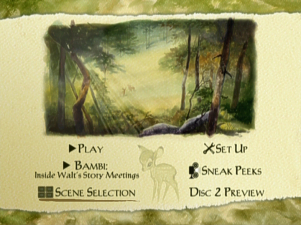
The latest in the “prestigious” Platinum Editions (so prestigious that we’re accelerating from one every year to two per annum with Bambi, so that the library will be out and recyclable for Disney’s descent into the HD market), Bambi is expected to feature a disc-shaking amount of supplemental material. As a fan of the 1997 LaserDisc edition, I was eager to find what had been added…
Playing the disc for the first time, and we’re immediately treated to a sneak of the next Platinum collection title, Cinderella, being made available for the first time on DVD this October 5. Hopefully, the title will undergo a little more restoration than what is offered here, as after Bambi’s illustrious presentation, I found Cinders to be looking a little drab, even if the image was sharper than the LaserDisc box set. Other Sneak Peeks, also available from their own menu, include the theatrical Chicken Little trailer, the direct-to-video Lilo And Stitch 2: Stitch Has A Glitch, the new Studio Ghibli wave, some products in the Winnie The Pooh, Jojo’s Circus and Princesses lines, plus a first look at the upcoming sequel Bambi And The Great Prince Of The Forest, which sees Star Trek’s Patrick Stewart in the fawn’s mentor role and doesn’t actually look too bad, until the cheesy pop song comes crashing in. More on this on disc two!
Onto the first – and main – feature in the Bambi Special Edition: Scene Specific Story Meetings With Walt Disney And His Crew. Introduced by Patrick Stewart (other than his involvement in the Bambi sequel, he also brings his usual authoritative tones to the supplements), this feature is almost like a commentary track in reverse! The best “director’s comments” are usually made after a long time has passed between the making and releasing of the picture, unlike the multitude of tracks nowadays which are recorded while the film is still in production. With these story meetings, the entire dialogue took place BEFORE a frame of the movie was shot, lending the track a unique perspective.
It seems Walt – ever the archivist – had a stenographer record the minutes of each Bambi story conference as it happened, and these notes have been recorded by amazingly authentic actors. Now, these voices haven’t just been matched to the picture… it gets even better than that! An entirely second version of the film, compressed to disc just as well as the original feature, plays out, with original artwork, stills, photos, rare footage, typed notes, musical staves and story sketches all matched up as the feature plays along in the background, or picture in picture. Often, there’s so much to be taking in that your pause functions will come in more than handy, but this is an exceptional ride and quite possibly the best feature I have ever witnessed on a DVD, Disney or otherwise.
Made possible by the film’s relatively short running length of just under 70 minutes, the Bambi story meetings is an exceptionally conceived and executed option, and seemed to me to be much preferable than an audio-only track composed of archive (and often hard to make out) interviews. A fantastic substitute for an actual commentary with Walt, it’s only made all the more magical by having voice actors portray the creators of the film (and who are all labelled onscreen as they speak) with such an unassuming nature, that one totally buys that this is Walt and company talking – I got shivers more than once! I won’t spoil this one for you, but definitely check it out. Brilliant!
Rounding off Disc One is a fairly pointless short preview for the delights of Disc Two, but I suggest skipping that and going right to the disc itself. Once there, another redundant feature I found was the Index, which doesn’t enable any quick access to the features themselves, but rather simply lists the three category headings found on the main page (?). Under Deleted Scenes, you’ll find a short introduction by animator Andreas Deja (who just suddenly appears, with no introduction) to two short segments cut from the movie in storyboard form. Winter Grass only lasts around thirty seconds, but Bambi’s First Snow, an alternate take on Bambi and Thumper’s frozen fun in which Bambi takes the lead, runs for two-and-a-half minutes, nicely presented reconstructed with new voice recordings.

Heading into Games And Activities (don’t worry – we’re not near the end yet – the best is yet to come!) and we’re presented with several options, all of which are geared to the younger set. The Forest Adventure does a pretty nice job of setting up Bambi’s world in three dimensions (and through the four seasons), aided by artwork from the film and selected animation cycles. With all the video involved here, I wouldn’t be surprised if this wasn’t what took up much of the space on Disc Two, but there’s a certain level of enjoyment to be had in the various choice and numbering games the player comes across along the way (though the acorn catching thing seemed pretty impossible and I gave up – luckily levels can be skipped)!
More kids stuff with DisneyPedia: Bambi’s Forest Friends, less attractive to look at but a lot more enticing! Using pre-restored clips from the movie and some archive footage, this four-minute piece looks at the real life animals to be found in Bambi’s world. What’s Your Season: Personality Profile, as you might guess, tells you which season you most represent given your answers to a number of questions (I was most like the fall), while Thumper Goes Exploring is a read aloud or read along Disney Storytime feature, with on-screen text and some limited animation techniques working well to tell the fairly chunky tale. Lastly, the Virtual Forest plays out like the aquarium on the Finding Nemo DVD… just an endless loop of the forest played out with some animation cycles from the film while the seasons come and go.
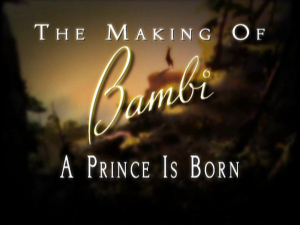
Heading behind-the-scenes into Backstage Disney, and here’s where you’ll find the meat of the meal, and the centrepiece bonus, the over 50-minute The Making Of Bambi: A Great Prince Is Born. This six-part documentary certainly digs deep into the production of Walt’s classic. A series of talking head interviews, we hear from such noted animation historians and filmmakers as John Culhane, Charles Solomon, Don Hahn, John Lasseter, Andreas Deja, Joe Grant, and Mel Shaw, among others, on what Bambi means to them and, of course, its production history and continuing influences (the Lion King’s debt is duly acknowledged). The lack of a linking host doesn’t present any hindrance, and the interviewees reveal much about the film, as well as heavily touching on discarded concepts.
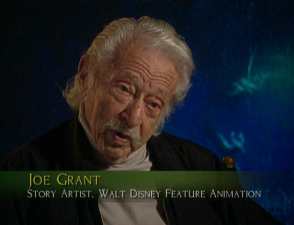
Unfortunately, Frank Thomas and Ollie Johnston were not interviewed for The Making Of Bambi, which overlooks the last of the animators to have contributed directly to the film, though many of Walt’s Nine Old Men are shown in archival sound bites that are a little misleading in that they are not labelled as such and casual fans could be mistaken for thinking that the clips are more recent than they are. However, and despite a little overlapping from the Story Meetings, this is overall an adult, intelligently put together piece that is aimed squarely at animation admirers and collectors. Some of the anecdotes will be familiar to long-time aficionados, but they are conveyed with an enthusiasm that makes them all new again. Any documentary that locates the original voice artists and treats the film with love, true affection and respect has to be applauded – and you can’t ask for much more than that!
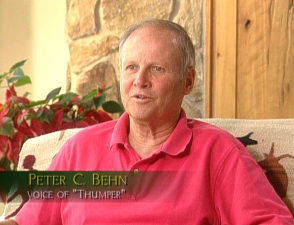
Restoring Bambi welcomes back Patrick Stewart, who takes us through the restoration process. The six-minute piece goes through the motions of explaining about deteriorating Nitrate negatives, the digitising and “dust-busting” of individual frames, and though the technique is still revolutionary, Stewart’s hyperbole does sound amazingly scripted and his “I think Walt would approve” comes off not sounding as sincere as it might have done coming from an Ollie Johnston, for example.
Stewart reappears in the five-minute promotional push The Legacy Continues, an extended look at the creation of the Bambi “mid-quel” due on Disney DVD next spring. Though being produced by DisneyToon Studios, the last unit of the company currently making traditionally hand drawn films, the animation in Bambi And The Great Prince Of The Forest doesn’t look half bad, certainly building on what the team have been aiming for in recent titles such as The Lion King 1½ and Mickey’s Three Musketeers. Once again, and as with The Jungle Book 2, although modern animation techniques mean that the images are crisper, one can’t get over the fact that the “innocence” and “acting” in the 1942 original will always outweigh the new artists’ “forced sincerity”. However, it’s story that counts, and we’ll have to see next year whether Bambi And The Great Prince Of The Forest really deserves the early negative word it’s been getting on the web – I’m willing to be convinced.
Disney Time Capsule 1942 – The Year Of Bambi plays like one of those Disney Studio Albums that featured on the Vault Disney series of DVDs, though here not just centering on achievements made at the Studio and taking in world history, culture, and Walt’s place in it all. Lasting four-and-a-half minutes, this is little more than a fluff piece that reveals nothing new to Disney fans, though perhaps places Bambi in context, even if the clip is happy to point out who won what at the Oscars that year but fails to mention Bambi’s three nominations, which also go unmentioned anywhere else too!
A collection of Still Frame Galleries are playable as a traditional “step-through” selection of stills, or as a slideshow (with or without additional audio descriptions on selected images), but there’s actually more to see if one goes via the manual option. Broken down into several sections, the galleries, covering development, production and promotional artwork, are labelled as Concept Art, Story Sketches, Color Keys And Backgrounds, Character Designs (for Bambi, Mother And Father, Flower, Friend Owl, Thumper and Faline), a series of original Posters, and a number of Production Stills showing behind-the-scenes photos. Though these images are used extensively throughout the supplements, it’s nice to have a chance to sit through them individually, and I counted well over a couple of hundred or so.
Next up is more fluff, depending on how one looks at it. The often-shown excerpt from Tricks Of Our Trade (here mislabelled as Tricks Of THE Trade) has Walt describing the Multiplane Camera and the use it has in animated cartoons. It’s a sequence that has been recycled on more than several occasions, and popped up in more than several Disney DVD presentations, though Walt’s pride with the camera is still apparent and he does point to Bambi’s opening as a prime example of its use, followed by a reconstruction of the crew setting up the filming of that scene. Though the clip looks as scratched and worn here as it always does (considering the usage the Studio gets from it, one wonders why a cleanup hasn’t yet been approved!), I would easily recommend the Walt Disney Treasures: Behind The Scenes At The Walt Disney Studios 2-disc set, for not only the full Tricks Of Our Trade program, but also some more background information on the Studio during the time Dumbo and Bambi were in full production.
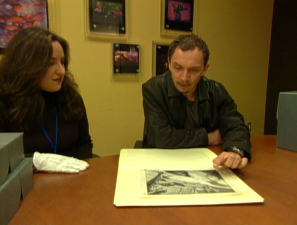
Moving on to Inside The Disney Archives and at first I was sceptical of what was in store, being wary of the extended filler that was palmed off to fans in the supplements on The Complete Pluto (Volume One!) set. However, once animator Andreas Deja’s infectious mood takes over, we’re given a delightful tour around the vaults, where many discarded story sketches are reconstructed as Andreas talks us through some additional deleted scenes. Running almost nine minutes, we also get to see color keys, background art and some deleted animation drawings!
The Old Mill, from 1937, was the “testing ground” for the Multiplane Camera. As the text that precedes the film announces, the Academy Award-winning short would allow the opportunity for the animators to hone their skills at portraying realistic animals, as well as the special effects of water, wind, rain and lightning, which would feature prominently in the Bambi feature. An amazingly detailed animated short (“cartoon” doesn’t do it justice at all), The Old Mill is, at well over eight minutes, probably the most ambitious of the Silly Symphony series. Certainly it is an important film, and a true work of art, telling of what happens to a group of animals whose tranquil, creaking hideaway is disrupted by a thrashing storm. Check out some of the animals in the short, and you may well spot some Bambi supporting players! Previously available on disc two of the Walt Disney Treasures: Silly Symphonies DVD, The Old Mill replaced my ageing VHS transfer, though I have to say that I hope it undergoes a bit more of a restoration someday, since the three-strip Technicolor elements look to be more than a little out of alignment early in the film and the print still suffers from a lot of dirt and flutter. Not the best The Old Mill has ever looked, it’s a shame that it couldn’t have been further cleaned up for this release, though it is a welcome inclusion and this stunning film will astonish those coming to it for the first time.
Finally, Bambi’s Original 1942 Theatrical Trailer, from an unrestored print, rounds things off. A rather severe narrator describes the “most powerful, gripping and romantic story ever brought to the screen”, and it’s interesting to see that, back then, it was the second, adult-half of the film that was mostly promoted to audiences. The inclusion of the trailer – something that the Platinums seem to keep for themselves – must be applauded, but the disc, especially for a Platinum release, does feel a little lightweight overall. Though it neither feels particularly skewed toward the kid-audience, features such as the Restoration demo and the push for Bambi’s sequel are, while interesting, not terribly groundbreaking and scream a bit of padding.
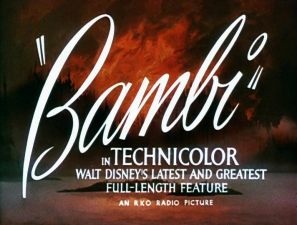
The 55th Anniversary LaserDisc edition packed in a few more touches: an isolated music and effects track, an additional, much more fun – and well worth seeking out – 1988 theatrical re-issue trailer, as well a different 15-minute Making Of The Masterpiece documentary which even ended, if I remember correctly, with a deleted, alternate version of a song for the Little April Shower sequence that isn’t included anywhere here.
While all of that would have been icing on the cake, it could have realty bolstered this particular edition. As it is, and coming after the feature-packed editions of Aladdin and Mary Poppins, how can we really complain? What has been assembled here does the job admirably, if not spectacularly. Of course, don’t get me started on perhaps including the 1982 television special on Disney Animation: The Illusion Of Life in which Frank and Ollie discussed the merits of animating the film and their particular fondness for Thumper!
Case Study:
Once again, the well-oiled Disney machine isn’t well oiled enough. Though Bambi comes to disc with the familiar “open book” cardboard slipcase, the artwork this time around extends all around the cover, putting an end to the Platinum line’s solid spine coloring (but nevermind… since when have the Platinums been consistent in the past?). The copy I had also didn’t have the usual Velcro fasteners inside, with the spot of gluey-gel used not strong enough to keep the foldout from popping open.
Inside, things are much better. In the first of a new promotional tool, we find the premiere copy of The Disney DVD Insider, an extension of the website page that looks at new Disney product coming to DVD. This first, 24-page issue, ONLY available in the Bambi: Platinum Edition set, features Chicken Little on the front cover, with additional news on the film inside, as well as spreads on Cinderella, National Treasure and an offer for an original theatrical poster of Bambi. Getting the big push in this issue, but something I actually found a little disconcerting was the idea of a “Disney Movie Night”, which all sounded a bit too…totalitarian. Most amusing was the “pick a theme like movies about the sea” – do they realize just how long it would actually take to watch Finding Nemo and 20,000 Leagues Under The Sea in one sitting?
The Insider is a welcome new addition to Disney’s biggest title releases, but it can’t compete with the essential DVD Guide, a foldout “map” of the DVD and where to find everything. Confirming Cinderella as this October’s Platinum Edition, the guide also officially announces Lady And The Tramp as March 2006’s release. Lastly, a small “Thumperiffic Savings” booklet actually has very little savings coupons inside, but is big on the promotional push for more Disney product.
Ink And Paint:
The beneficiary of a state-of-the-art digital cleanup by Lowry Images, Bambi has been restored to what is supposedly its original theatrical brilliance (even more brilliant than the previous two times it has been restored and released to video, apparently). In truth, Bambi shines, but is just in danger of becoming a little TOO bright and clean. Whether or not this is really what the artwork down in Disney’s “morgue” looks like, the colors here are vibrant and look brand new, but without stealing the grain inherent in Walt’s 1940s film stock and retaining the “film-look” that those who have read any recent reviews will find I prefer over the clinical approach of some digital-to-digital transfers, especially with the blander direct-to-video releases.
Compared to the Limited Edition LaserDisc, Bambi certainly looks more pleasing – it reminded me of the makeover given to Sleeping Beauty, where the backgrounds, when static, really do not move, and characters’ outlines become sharper. Of course, there are the tricky camera pans and moves, such as zoom-ins, that still hinder the software a little (with imperfections being harder to spot between frames and a slight “digital trail” on some fast movements) but on the most part, Bambi looks great, and the compression is kept well up in the sixes and eight megabits per second. If anything, the new DVD loses a tiny bit of shadow detail and sharpness compared to the LaserDisc, but it’s a trade off that I’m happy to accept, based on the freshness and clarity of the image (a couple of animation glitches, previously fixed, have been returned to their original state too, such as Bambi’s mother’s emergence from the bushes after the first Man scare) – and one can actually see the planes of glass used in the more elaborately set up shots!
Presented in its original 1.33:1 Academy ratio, the one other “surprise” to watch for is the replacement of the original RKO distributor’s card with the familiar blue Disney castle logo, as well as some pages of restoration credits, very nicely created in the style of the film’s opening title cards. The bright colors, which reminded me of Brother Bear’s post-transformation palette, may take a little getting used to (check out that sunset at the end of Little April Shower!), but the deep reds and greens are preferable to the muted browns and the image does add a sliver to all sides, compared to the LD. There are some that will complain that that this Bambi looks “too new”, and I have to admit to possibly preferring the LD restoration in places, but if this was the original intention, then so be it – Bambi has rarely looked better!
Scratch Tracks:
Considering that one of Bambi’s Oscar-nominations in 1942 was for Best Sound recording, one would think that the original track could cut the mustard with today’s audiences. Or, you could take the view – as Disney has – that those tracks would mean an excellent basis for creating a new 5.1 Dolby Digital mix. Presented as the latest in Disney’s Enhanced Home Theater re-jigs, Bambi stays pretty faithful to the original (purists needn’t worry: unlike Mary Poppins, the original-but-cleaned-up mono track is present and correct here too).
Of course a re-mix of a 1940s film, Bambi isn’t going to shake the room or knock your socks off in the way The Lion King’s EHT mix did, but the subtle placing of several effects does “open up” the film a little more and it sounded better to me than the Dolby Surround LaserDisc. But it’s not all perfect – as usual with these endeavours, the track exhibits some instances of “phasing” in the music, and the stereo-spaciousness does sound a little “boxy” in the choral reproduction. In truth, I was still very satisfied with the original mono track, which sounds alive and less fussy, perhaps more in keeping with the film’s production era. French and Spanish 5.1 dubs are also included, as well as a THX Optimizer for system set up.
Final Cut:
One of Walt Disney’s defining moments, Bambi is the film that has delighted – and frightened – generations. The closest the Studio ever got to balancing the mix between art and mass-audience pleasing narrative structure, Bambi remains a vital part of the Disney animation legacy. For once, the Studio hype and all the critics’ praise is right: Bambi is now a true classic, and as I mentioned above, it is perhaps the last of that opening series of important Disney films that saw the Studio establish itself as the masters of the medium for at least five decades or so.
Putting it short: Bambi deserves the accolade of “masterpiece”, and though this 2-disc set might not live up to Platinum expectations, the Story Meetings “commentary” really should put an end to any complaints – it is an outstanding contribution in understanding the way Walt worked at his Studio during this most creative period and the closing of the Golden Age. For any collector of the Platinum series, those who enjoy or work in animation in general, or anyone who just likes charming stories turned into great movies, Bambi is simply a must!
 | ||
 |







